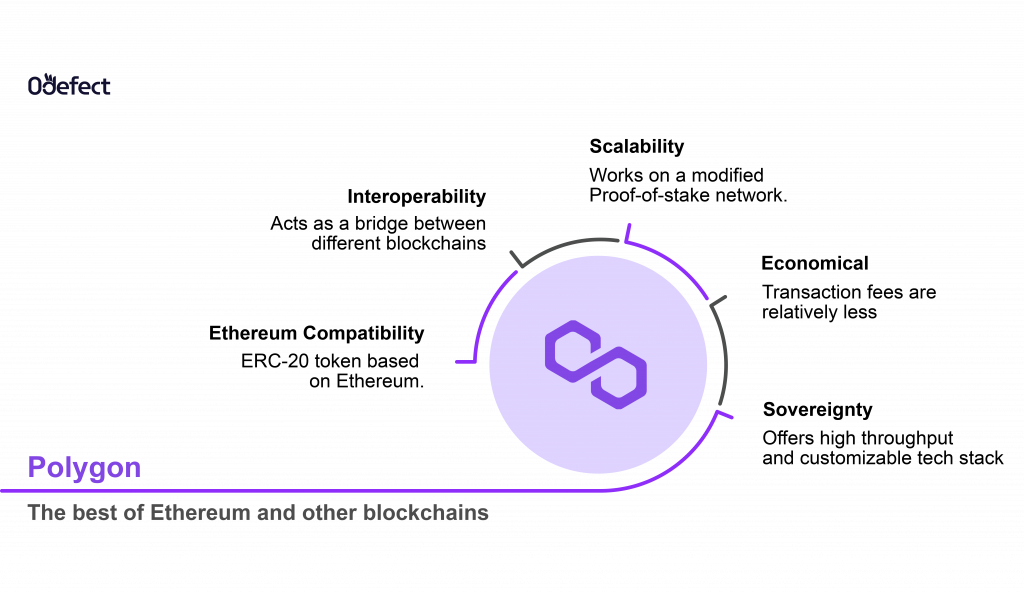The Ultimate Polygon Smart Contract Audit Guide
There has been a distinct shift after Polygon came in 2017. Being a one-of-a-kind layer 2 solutions, Polygon has shown enormous potential and has been on a consistent growth path. Along with this, a Polygon smart contract audit guide ensures the ultimate security of the network. It is a proactive solution for blockchain security.
The Polygon blockchain offers excellent scalability, sovereignty, and flexibility. With more than 1 billion transactions to date, the Polygon is the leading platform for scaling and infrastructure.
Considering the recent developments, there is a belief that it will be a borderless system for everyone. Needless to say, a polygon smart contract audit highlights the errors and, by systematic efforts, strengthens the network.
You may know it or not, but Polygon has a connection with Ethereum, the second most popular cryptocurrency! Let’s understand more about Polygon and how it operates alongside the Ethereum network.
Polygon and its connection with Ethereum
Ethereum is compatible with smart contracts, and Polygon is its sidechain. It uses the same smart contract functionality as Ethereum. Also very similar to Ethereum, it supports a varied range of applications.
In December 2021, Ethereum crossed the transaction fee of an average of $25. With Ethereum being congested and laden with network bottlenecks, Polygon acts as a savior. To understand more, let’s look at the primary difference between both platforms.
| Features | Ethereum | Polygon |
| Foundation Year | 2013 | 2017 |
| Token | ETH | MATIC |
| Transaction Speed | 13-15 per second | 65000 Per second |
| Language | Solidity | Golang, Solidity, Vyper |
| Consensus Mechanism | Proof-of-work and Proof-of-Stake in 2022 | Proof-of-Stake Plasma Based Chain |
Polygon has mastered 65,000 transactions per second of speed. Something that other blockchains wish they could do.
The consensus mechanism of Polygon is “modified proof-of-stake.” Mainly, Polygon fixes two of the Ethereum issues:
- High Transaction fees
- Slow Transaction speed
What is MATIC aka Polygon?
Ever wondered why you often hear the term MATIC and polygon together? Are they even related?
Well, MATIC is the cryptocurrency of Polygon, very similar to ETH for Ethereum. MATIC is also used as a gas fee on the Polygon network and works on the ERC-20 standard.
The rebranding of MATIC happened in Feb 2021. Before you confuse a little more between MATIC and Polygon — MATIC network was the former name for Polygon.
Does Eth 2.0 affect Polygon?
With Eth 2.0 currently at a nascent launch stage, Polygon is gaining more advantages day by day. A Polygon is a side chain or a parallel blockchain that works on Ethereum.
The network employs the Polygon is more potent as it combines the best version of Ethereum and other blockchains. Therefore, Eth 2.0 still needs to work a lot to be “head and shoulders above” Polygon.
However, Vitalik Buterin, Ethereum’s co-founder, has said
“That the technologies may co-exist. It’s difficult to place too much emphasis on Ethereum 2.0 when considering MATIC’s future, given that the protocol plans to expand to other blockchains, and that interoperability solutions like Cosmos may make the industry less reliant on protocols like Ethereum, naturally spreading the load of computational work across other blockchains.”
Moreover, the major problem arises when one has to work on Defi or NFT as the transaction fees keep rolling into a ball.
What makes Polygon stand out?
The fast speed of Polygon helps it to deal with real-life scenarios. The multi-chain system also amps up security. A few of the best features of Polygon are:
- Compatibility with Ethereum gives the blockchain dominance over other networks.
- Provides interoperability for tokens, and contract call thus acts as a bridge.
- It has a scalable consensus algorithm and has EVM as an execution environment.
- Has sovereign governance, which means that it has a dedicated line-up of resources. On top of it, it has a fully customizable tech stack.
- Polygon has arbitrary message passing capability which means that it can communicate with one another and can also communicate on Ethereum main chain.
- It has a modular architecture where one can transfer pre-configured blockchain with just a click.

The basic framework of Polygon
There are four distinct layers in the polygon network, with every layer having its own unique function.
Polygon has a multi-layer infrastructure. An Ethereum layer is used as the foundation to implement polygon smart contracts. Along with it, there is a side-by-side security layer and an additional layer to protect by “validators as a service” roles. Then it’s the Polygon network layer. Every network on Polygon runs on a
- Local consensus
- Has a block production
- Transaction collation
Last but not least, there is an execution layer. The execution environment is EVM and execution logic is a state transition function.
Chains of Polygon
You must know why the transaction fee is low. The reason being simple is that the Polygon uses multiple chains to improve scalability on the network.
POS Chain: Polygon uses Ethereum’s side chain known as Matic POS, which adds up as a proof-of-stake(POS) security layer to the network.
ZK-rollups: Zero-knowledge rollups collect together a large number of transactions into a single transaction, and maintain it on the Ethereum main chain.
Plasma Chains: Polygon has a unique scaling technology called Plasma Bridges which is used for the movement of assets.
Optimistic Rollups: It is a solution that works on Ethereum to ease instant transactions by using “fraud-proofs”.
What is layer 2?
The term signifies that it is a secondary scaling solution that works on the Ethereum blockchain. Simply put, Polygon doesn’t require a primary blockchain; it operates side by side with Ethereum. It is an add-on layer to the existing Ethereum blockchain.
Advantages of Polygon
- Polygon’s average transaction speed is 2.1 seconds as the transaction gets achieved in a single block.
- True to its words, the blockchain has the lowest transaction at $0.01.
- Provide developers with a wide range of tools for deploying polygon smart contract protocols, dApps, etc.
Disadvantages of Polygon
- One disruption on the Ethereum network is enough to stop Polygon from working.
- MATIC currency comes with limited uses and is not viable for everyday purchases.
The Popularity of Polygon
On the growth front, Polygon offers better interoperability. Something that is still not present in many other blockchains. In 2021 Polygon also entered the world of NFT and blockchain gaming as well.
Want to know more about the Importance of NFT smart contract audit? Read it here.
Thanks to its scalability and providing a solid infrastructure for Web3, the polygon platform has more than 7000 dApps running on it to scale its performance.
6 Easy Steps to Deploy Polygon Smart Contract
Finally, you will learn how to polygon smart contracts. You require a polygon node, metamask installed in the browser. Also, if you are confused regarding the language of Polygon, it’s none other than Golang, an open-source programming language.
- Add an RPC endpoint in your MetaMask wallet. The step is essential for the transaction of the MATIC tokens.
- Start the extension by clicking on the fox icon. Click on the identicon icon on the top right. Select networks from the settings menu and then add networks.
- Use Matic Faucet to add Mumbai MATIC tokens by pasting your account address into text input and finally submitting. The faucet adds 0.1 test MATIC to the wallet.
- From Truffle configuration, you will configure the paths to the solidity files.
- Create a .env file and paste the same into the 12 word Secret Recovery Phrase of MetaMask Wallet.
- After adding the matic network in the truffle.js file. Add the network ID for Mumbai, which is 80001.
We assume you have a beginner level of experience in blockchain and coding. If you want to understand more about coding from truffle to deploy Polygon Smart Contract check the tutorial here. Now, the smart contract is deployed. It’s your turn to interact more with it.
Issues with Polygon
Earlier in May 2021, Polygon also stated on its Twitter handle that only one potential exploit is enough for the hackers to steal users’ information.
In the tweet, Polygon explained how they have custom “Child ERC20” upgrades and mapping on the contracts. This step ensures the security of Polygon smart contracts.
However, in Dec 2021, hackers were able to scrap $2.4 million. Polygon silently fixed the issue without letting anyone know and somehow was able to save $24 million. However, this still puts a question mark on the smart contracts functionality of Polygon.
Importance of Polygon Smart Contract Audit
With so much data and vast amounts of transactions on smart contracts. Hackers always keep an eye on the minor coding errors that they can tap anytime soon! The risk of transactions getting stolen or, in the worst-case scenario, getting hacked is always there. A Polygon Smart Contract Audit will lead you to:
- A Quick Fix of the bug
- The smooth running of projects
- A robust review of potential vulnerability
The 0defect’s Polygon Smart Contract Audit will help you secure assets worth millions and enhance smart contracts’ performance. And will help your business to earn decent value in the market.
4 Steps for Polygon Smart Contract Audit
Like every other framework, a polygon smart contract audit is essential before deploying it on the mainnet. Furthermore, your business will receive a successful launch and help you make better connections with investors. Take a look at how 0defect follows a holistic and extensive four-way process to perform the smart contract audit.
- Specification gathering – Our dedicated team believes in understanding the root cause of the problem, and this is why we have extensive meetings with developers to discuss the details.
- Review – Our passionate audit team looks at even the smallest details. A thorough evaluation is done for vulnerabilities such as re-entrance, time-manipulation, overflows, etc.
- Detailed Testing – Our expert team spotlights the errors. Smart contracts undergo deployment on an IDE to check function behavior and gas consumption.
- Final Reporting – The code goes through automated tools, and a detailed audit report is presented. After a few initial fixes, our team again repeats process three and delivers the final audit report.
Closing Thoughts on Polygon Smart Contract Audit
You may think that “Is Polygon the next big thing in the crypto world”? Undoubtedly, yes, it is! Several decentralized exchange platforms, metaverse like Decentraland, use Polygon as their scaling platform. In addition to that, like every other blockchain, Polygon has also entered the NFT segment.
No doubt, there is an upward trend to be seen. Polygon has a bright future as the blockchain evolves every day with smart contracts functionality. And a polygon smart contract audit will add more credibility to it.
We are industry experts in blockchain and polygon smart contracts audits. Request a quote today or reach out to us to understand more about the polygon smart contracts audit. Hope this Polygon Smart Contract Audit Guide helped you, do share your thoughts with us.








